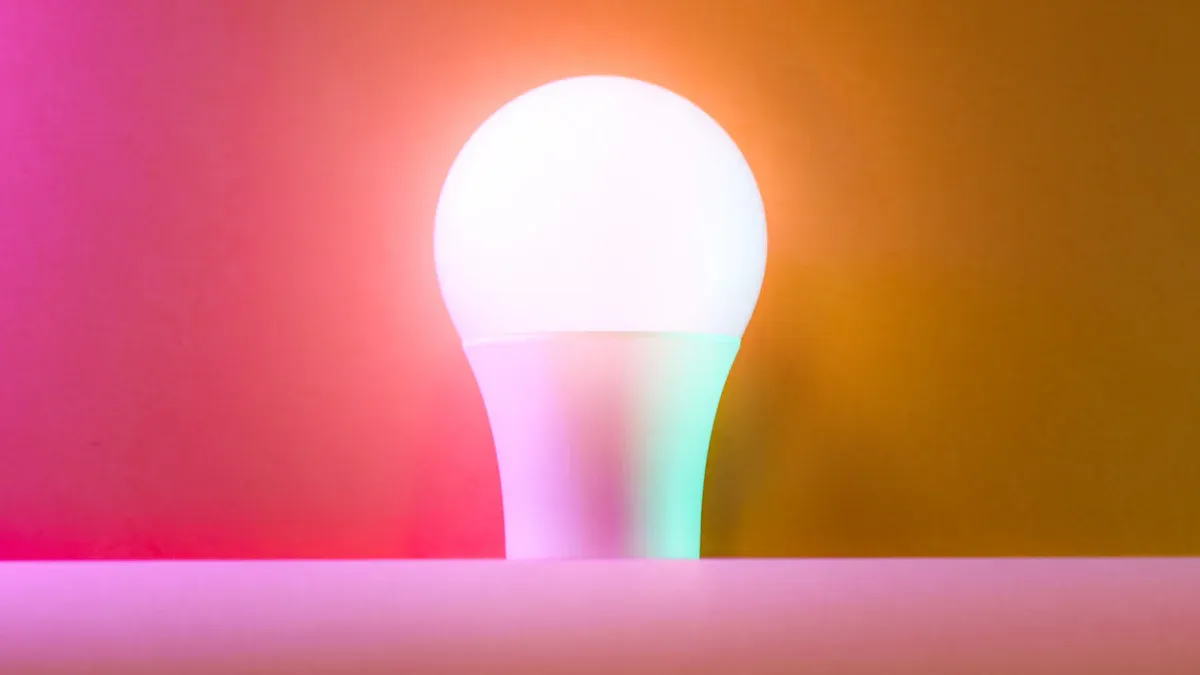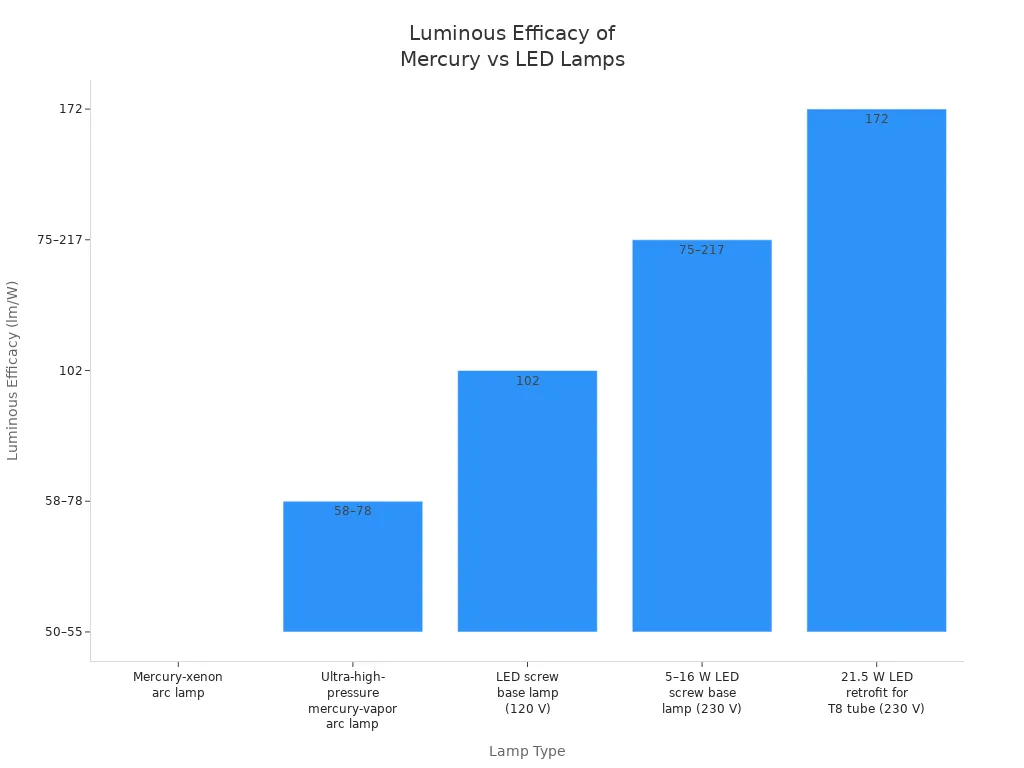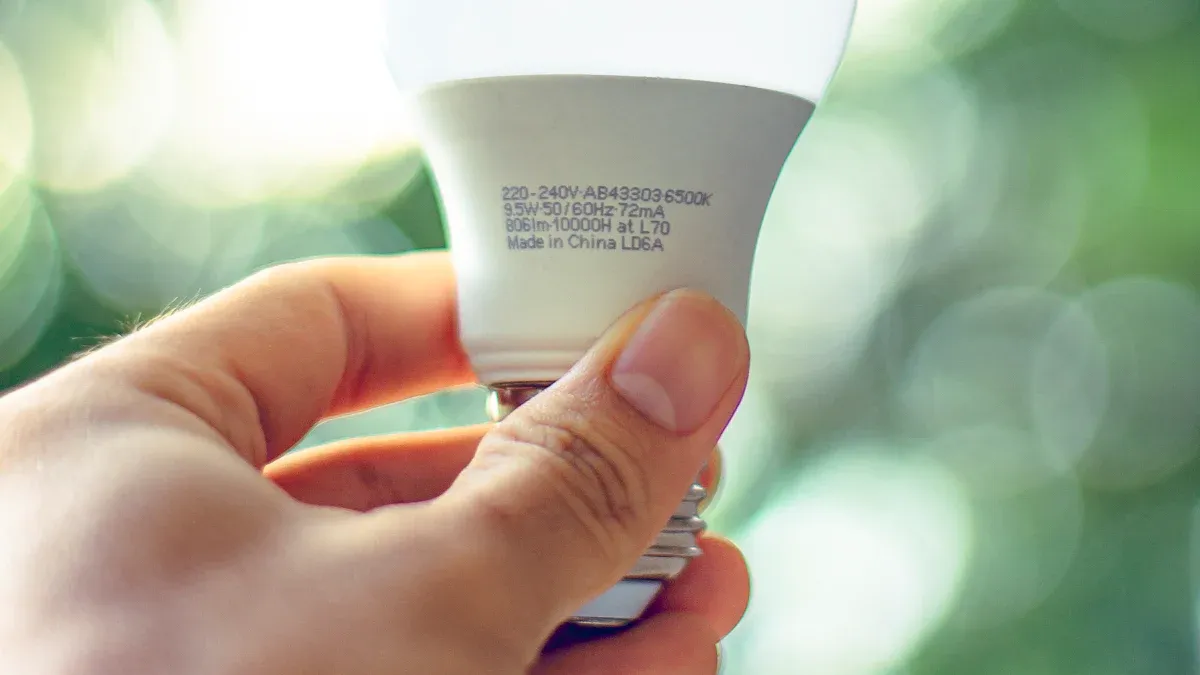Mercury Lamp Bulbs: Efficiency, Environmental Impact, and LED Replacement Options

Mercury lamp bulbs use more energy than newer lights. They also cause more harm to the environment. Many governments limit their use because mercury is dangerous. There are also strict rules for throwing them away. People at home and at work now like led lighting better. Led lighting saves more energy, lasts longer, and is safer to get rid of. New data shows led bulbs use up to 40% less energy than fluorescent lamps. Led bulbs also last much longer than old bulbs.
Switching to led technology helps keep people and nature safe. About Us and Product pages often talk about these good things. This makes Led Light upgrades a smart idea.
Key Takeaways
Mercury lamp bulbs use more energy. They have toxic mercury inside. Mercury can hurt people and the environment.
LED lights use up to 40% less energy. They last longer than mercury lamps. LEDs also cost less to take care of.
Using LEDs lowers your electric bills. It also cuts down on pollution. This helps keep people and nature safe.
LED bulbs do not need ballasts. This makes them safer. They are also easier to put in and take care of.
If you plan your switch to LED lights, you can save money. Using the right products and rebates makes it easy.
Mercury Lamp Bulbs Overview
How Mercury Lamp Bulbs Work
Mercury lamp bulbs make light in a special way. They have mercury vapor inside a closed tube. Here is how they work:
Electricity moves through the tube with mercury vapor and a little inert gas.
The electricity excites the mercury vapor. This makes atoms give off energy as light. Most of this light is ultraviolet and visible.
As the lamp gets hotter, the pressure and temperature inside go up. At first, the light looks blue. It turns brighter and whiter as pressure rises.
Many mercury lamp bulbs have a phosphor layer on the outside. This layer changes ultraviolet light into visible light. It helps colors look better.
The lamp has negative resistance. It needs a ballast to keep the current safe and stop damage.
How well the lamp works depends on vapor density, phosphor, wattage, and electrode shape. Most lamps give 35 to 60 lumens for each watt.
The lamp’s temperature and electrodes affect how bright it stays and how long it lasts.
Some mercury lamp bulbs have a tungsten filament. This filament helps control the current. It also adds red light, which makes colors better but lowers efficiency.
Note: Mercury vapor gives these lamps their special light and also causes environmental problems.
Common Applications
Mercury vapor lamps have been used in many places for years. Their strong white light and long life make them useful in many ways:
Street lights in cities and towns
Lights in gyms and sports arenas
Lighting in banks and stores
Factories and big work areas
Many places use mercury vapor lamps because they are bright and last longer than incandescent bulbs. They also save energy, so they are good for lighting big spaces for a long time. Some places still use mercury lamp bulbs where strong light and toughness are needed. But now, many groups are changing to LED lights because they are safer and work better.
Efficiency Comparison
Mercury Lamp Bulbs vs. LEDs
Mercury vapor lamps and LED lights use different methods to produce light. Mercury vapor lamps rely on mercury vapor inside a glass tube. When electricity passes through, it excites the vapor and creates light. LED lights use semiconductor diodes. These diodes emit light when powered by electricity. The difference in technology leads to a big gap in efficiency.
The table below shows how much light each type produces for every watt of energy used. This measure is called luminous efficacy.
Light Source Type | Luminous Efficacy (lm/W) |
|---|---|
Mercury-xenon arc lamp | 50–55 |
Ultra-high-pressure mercury-vapor arc lamp | 58–78 |
LED screw base lamp (120 V) | 102 |
5–16 W LED screw base lamp (230 V) | 75–217 |
21.5 W LED retrofit for T8 fluorescent tube (230 V) | 172 |
LED lights outperform mercury vapor lamps in every category. High-performance LEDs can reach up to 220 lumens per watt. Mercury vapor lamps usually stay below 80 lumens per watt. This means LED lights use less energy to create the same amount of light.

Note: The higher the lumens per watt, the more efficient the light source. LED lights provide more light for less energy.
Energy Use and Cost
Mercury vapor vs. LED shows a clear winner in energy use. Mercury vapor lamps need much more energy to run. For the same brightness, a mercury vapor lamp can use over ten times more energy than an LED system. This difference leads to higher electricity bills and more strain on power grids.
Mercury vapor lamps have high power consumption.
LED lights use less power and give the same or better light.
Over 25,000 hours, mercury vapor lamps cost much more to operate.
LED lights offer big energy savings and lower carbon footprints.
Mercury vapor vs. LED also affects the environment. Mercury vapor lamps contain toxic mercury, which adds risk during use and disposal.
LEDs last longer and use less energy. This means lower costs for homes, businesses, and cities. Many organizations report saving thousands of dollars by switching to LED lights. The energy efficiency of LEDs also helps reduce greenhouse gas emissions.
Lifespan and Maintenance
Mercury vapor vs. LED also matters for how long bulbs last and how often they need replacing. Mercury vapor lamps usually last between 6,000 and 15,000 hours. LED lights can last from 15,000 up to 50,000 hours or more. Some high-quality LEDs even reach 100,000 hours.
Light Type | Typical Lifespan (Hours) |
|---|---|
Mercury vapor lamp (CFL) | 6,000 - 15,000 |
LED | 15,000 - 50,000 |
LED lights need fewer replacements. This reduces maintenance work and costs. Mercury vapor lamps often need ballasts, which can fail and add to repair costs. LEDs do not need ballasts, so they are easier to install and maintain.
LEDs also generate less heat than mercury vapor lamps. This can lower cooling costs in buildings. Mercury vapor vs. LED shows that LEDs are safer, last longer, and cost less to maintain.
Tip: Choosing LED lights means fewer bulb changes, less waste, and lower long-term costs.
Environmental Impact

Mercury Risks
Mercury lamp bulbs are bad for the environment because they have toxic mercury vapor. If these bulbs break or leak, mercury vapor gets into the air. This vapor is very dangerous and can pollute the environment. Different mercury vapor lamps have different amounts of mercury. Compact fluorescent lamps have 3-5 mg, but big industrial bulbs have more. If a mercury vapor lamp breaks, the mercury vapor can go above safe levels. This is worse in small rooms or places with little fresh air.
Breathing in mercury vapor can hurt the nervous system. People might feel tired, forget things, shake, or have mood swings. Kids and pregnant women are at higher risk. The World Health Organization says mercury is one of the top ten most dangerous chemicals. Even one broken bulb can let out enough mercury vapor to need careful cleaning. Handling and throwing away bulbs with mercury the right way helps keep people and nature safe.
Note: Mercury vapor lamps should be kept in closed containers so they do not break and let out mercury. If a bulb breaks, clean it up right away to stop pollution.
Disposal and Waste
Throwing away mercury lamp bulbs is hard for the environment. If not done right, toxic mercury vapor can get into the air, water, and ground. This causes mercury pollution. Many places treat bulbs with mercury as hazardous waste. The Toxicity Characteristic Leaching Procedure (TCLP) checks if a lamp is dangerous by testing how much mercury can leak out. Even bulbs with less mercury need to be handled and recycled carefully to stop mercury vapor from escaping.
Only about 25% of bulbs with mercury get recycled. There are many reasons for this:
Some lamps pass the TCLP test and are not called hazardous waste, so recycling is not needed.
Small businesses and people at home often do not recycle mercury vapor lamps.
Some states, like California, have stricter rules and make everyone recycle bulbs with mercury.
Mercury inside the lamp can be solid, liquid, or vapor, which makes recycling hard and risky for workers.
Some parts of the lamp, like the glowing powders, are not recycled and end up in landfills, which hurts the environment.
Groups and special programs are trying to help more people recycle bulbs and fix rule problems. Recycling and throwing away bulbs the right way helps stop mercury pollution and keeps the environment safe.
Regulatory Bans
Many governments know that mercury vapor lamps are bad for the environment. They have started to stop people from using them. The European Union banned most fluorescent lamps with mercury by 2023 with the RoHS Directive. This ban helps lower mercury pollution and keeps people healthy. The EU also works with the Minamata Convention on Mercury to stop mercury use around the world.
In the United States, there is no full ban on mercury lamp bulbs. But there are strict rules for storing, throwing away, and sending out products with mercury. Some states have even tougher rules for recycling and disposal. In Asia, it is hard to stop using mercury vapor lamps because there are not enough recycling centers. But countries like Indonesia and the Philippines have started to stop using them in hospitals and other places.
More places are switching to LED lighting to get rid of mercury vapor lamps. These changes help the environment and stop mercury pollution. Using LEDs instead of mercury lamps makes the world safer and cleaner.
Benefits of LEDs
Energy Savings
LED lights help save a lot of energy everywhere. When cities use LED lights instead of mercury lamp bulbs, they use much less electricity. Some cities see their power use drop by half or even more. For example, Springfield changed 10,000 streetlights to LEDs and saved 55% on energy costs. In offices and factories, LED lights can cut lighting bills by up to 70%. The table below shows how much energy and money different places save:
Application Type | Example | Energy Savings (%) | Cost Savings (%) | Notes |
|---|---|---|---|---|
Municipal | City of Springfield | 55% | Converted 10,000 streetlights | |
Commercial | GreenTech Offices | N/A | 60% | Mid-sized office lighting |
Industrial | Bright Manufacturing Plant | N/A | 70% | Large-scale plant lighting |
LED lights are the best choice for saving energy and money. They last a long time and do not need much fixing. This means cities and businesses get their money back fast, sometimes in just two months.
Environmental Advantages
LED lights are better for the environment. They do not have toxic mercury like mercury lamp bulbs. Using mercury-free LEDs helps keep people and nature safe. If every home in the U.S. changed one bulb to an LED, it would stop 9 million pounds of greenhouse gases each year. If everyone switched to LEDs, the country could cut 18 million metric tons of CO2 by 2030. LEDs also use about half as much energy as fluorescent bulbs. This helps the planet and lowers pollution.
LEDs give clean light without toxic mercury.
They save energy and help protect the earth.
Using less energy means less pollution and more good for the environment.
Lighting Quality and Safety
LED lights make homes, offices, and public places brighter and safer. They turn on right away and come in many colors. Most LEDs have a high Color Rendering Index, so colors look real and bright. LEDs do not get very hot, so they lower fire risk and keep rooms cool. Their strong build means they do not break easily if bumped or dropped. LEDs can last up to 50,000 hours, so you do not have to change them often. This means less waste and fewer replacements. All these things make LED lights a smart and safe choice for everyone.
Tip: Pick LED lights for better light, more safety, and to help the planet.
Switching to LEDs

Removing Ballasts
Many mercury lamp bulbs need a ballast to work. When you switch to LED lights, most new bulbs do not need a ballast. Taking out the ballast makes the system safer and better. Electricians call this a "ballast-bypass" or "direct-wire" job. They take out the old ballast and connect the LED bulb right to the power. This lowers the chance of the ballast breaking and means less fixing later. Without the ballast, the system uses less energy because no power is lost in the old part. Always turn off the power before you start. If you are not sure what to do, ask a licensed electrician for help.
Choosing LED Replacements
Picking the right LED lights takes some planning. These things help make the change easy:
Make sure the wattage and lumens match for the right brightness and to save energy.
Pick the color temperature you want, like warm white for homes or cool white for offices.
Check the base type, such as the mogul (E39) base, so the bulb fits.
Find out if the new LED needs a ballast or works better with a ballast-bypass.
Look for safety marks like DLC listing or UL certification to know the bulb is safe and works well.
Compare prices and warranties to get the best deal and protection.
Think about the safety and earth-friendly benefits, like no mercury and a longer life.
Tip: Certified LED lights give clean light and work well in every place.
Transition Tips
Switching to LED lights can be tricky. Some people worry about the higher cost at first or do not know which products are good. Some LED lights do not work with old dimmers, and too much heat can make bulbs not last as long. To make things easier, start by changing lights in places you use a lot. Pick LED bulbs with clear labels and trusted safety marks. Use dimmers made for LED lights to stop flickering. Make sure the room has good airflow to keep bulbs cool. Utility rebates and government deals can help pay for new LED lights. Programs like DSIRE and Energy Star's Rebate Finder show local deals. Many utility companies, like Pacific Gas & Electric and PECO, give money back for LED upgrades. These rebates can be a set amount for each light or based on how much energy you save. Talk to your utility company early to save the most money and make sure you can get the rebate.
Note: Good planning and picking quality products make switching to LED lights easy and save money.
Mercury vapor bulbs are not good for today’s lighting needs. They use too much energy and cost more money. They also hurt the environment. Cities like Houston and Springfield changed their streetlights to LEDs. This helped them save millions of dollars and lower pollution. LEDs last longer and use less energy than mercury vapor bulbs. LEDs do not have mercury vapor inside. The table below shows how big places save money by switching:
Installation | Energy Savings (%) | Payback (years) | |
|---|---|---|---|
Bright Manufacturing | $35,000 | 70% | 1.4 |
Springfield | $550,000 | 55% | 4.55 |
LEDs help protect the earth and keep people healthy. Choosing LEDs helps cities and businesses avoid mercury vapor risks. It also helps make the future safer for everyone.
FAQ
What should people do if a mercury lamp bulb breaks?
People should open windows and leave the room for 15 minutes. They should wear gloves and use stiff paper to pick up pieces. Place all waste in a sealed bag. Take it to a hazardous waste center.
Can LED bulbs fit in old mercury lamp fixtures?
Most LED replacements fit standard fixtures. People should check the base type and voltage. Some fixtures need rewiring or ballast removal. Always follow the manufacturer’s instructions for safe installation.
Are LEDs safe for the environment?
LEDs do not contain mercury or other toxic materials. They use less energy and last longer. This reduces waste and pollution. Recycling programs accept most LED bulbs.
How much money can switching to LEDs save?
Switching to LEDs can cut lighting costs by 50% or more. Many cities and businesses report thousands of dollars in annual savings. The payback period often ranges from one to five years.
See Also
Comparing Sodium Lighting And LED Options For Efficiency And Impact
Choosing Industrial LED Bulbs For Performance And Practical Uses
Benefits Of LED Street Lights In Energy And Longevity

